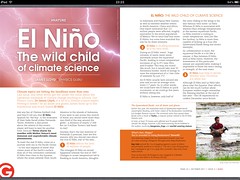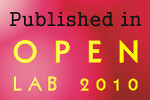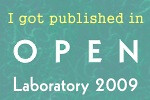This week I got to visit a part of London that is for me a hallowed place – the offices of The Guardian newspaper. I was participating in a workshop for the people who had been short-listed for the Wellcome Science Writing Prize, which is sponsored by the Guardian, and so made my way to its large glass headquarters behind Kings Cross.
I noted the personal significance of the occasion at the beginning of my remarks to the workshop participants. Alok Jha told me later he thought I had been joking. My sense of humour gets the better of me sometimes, but this time I was not speaking lightly. I have read The Guardian for as long as I have been reading newspapers because it was one of the papers that my father bought every day of his working life.
The Guardian isn’t everyone’s favourite read but it is mine and it was a real privilege for me to be part of it, if only for an afternoon. My remit in the workshop was to speak from the perspective of a scientist about science blogging. I told the assembled young writers how I approached it — extremely gingerly at first but with growing confidence — and then explained a little of the technical details of getting starting and staying in the game.
The other speakers at the workshop were Michael Reigner of the Wellcome Trust, who gave useful pointers on good writing, and James Randerson, The Guardian’s science editor, who outlined what he looks for when a freelancer pitches a story.
I’d like to wish anyone aiming to freelance as a science writer the very best of luck. James Randerson was up front about the tough times facing the newspaper industry, though he took care to offer some hope. He referred us to the Cudlipp lecture given by Guardian editor Alan Rusbridger in January of last year, which dissected the challenges facing journalism in the digital age. Though already 18 months old — the talk predated the iPad by a few weeks — Rusbridger’s analysis still seems on the money, even if the money is an increasingly uncertain quantity (a useful reminder that the scientific careers are not the only ones troubled by a doubtful future). His examination of the problem is clear-sighted but, despite the steady decline in newspaper sales, retains a sanguine eye on the future. The survival of journalism is important because, as we have been reminded in recent days, weeks and months with Liam Fox’s resignation, the exposure of phone hacking at the News of the World and of MP’s mis-use of expense claims, it serves a vital investigative function in an open society. The survival of journalism is something we should all be thinking about.
The lecture is long, but well worth reading. On a technical level it struck me that some of the difficulties — and opportunities — that the rise of the internet poses to traditional print journalism parallel those in academic publishing, a subject I have discussed recently and hope to return to. Randerson seems to have picked up on Rusbridger’s optimism and tweeted on Friday night:
@Stephen_Curry Sounds cheesy, but it has been and continues to be genuinely exciting. Feels like we are reinventing how to do news
The reinvention is due to the acceleration of news gathering and dissemination that is enabled by new technologies, but specifically involves the ability to link to sources, to engage other media — audio and video as well as the written word — and to involve the reader in reporting and commentary. The latter is something of a mixed blessing, as anyone who has perused a Guardian comment thread will know, but it is a feature that readers have come to expect.
The re-working of news also involves new ways of providing content. You can already get The Guardian on your iPhone but an app for the iPad was released earlier this week. It’s on free trial at the moment but will eventually cost you £9.99 a month. I tried it out today instead of buying the Saturday edition.
It’s too early to pass sound judgement on whether this is the future of newspapers. The interface is pretty slick and easy to use. The organisation of sections is similar to the newspaper though I’m not sure if it maps exactly to the printed edition; I couldn’t find the magazine section and so missed Tim Dowling’s funny column on family life. The layout of the front pages of each section seems a little picture-heavy to me, which limits the number of items on a single screen, a feature that slows down navigation through the content. I hate to say it but the Times iPad edition, which has gone for a more newspaper-like motif and has a denser layout of article thumbnails, feels better. But perhaps that is because the layout is more traditional so there is less of a rupture from my habitual reading experience. As a further sign of this problem of transition, I also missed the paper — the rustle and foldability — in using these screen-based versions, but that’s probably just nostalgia and will fade.
Coincidentally, parenthetically and finally, I came across another new publication for the iPad this week, a science magazine called Guru, which is produced by a team containing Stuart Farrimond, one of the short-listed science writers attending the workshop on Wednesday. This slickly designed science and lifestyle magazine is published only in electronic form every two months.
Guru is an impressive example of the power of digital technology. The magazine is created entirely by the voluntary efforts of a band of enthusiasts and is provided free. It may be an amateur effort but these days amateur efforts can easily look very professional. It made me think again about the plight of the academic author — and reader. As Research Libraries UK seek to face down journal price hikes from Elsevier and Wiley, it seems more and more like the right time to reinvent academic publishing.








Thanks for the interesting blog post. Can you clarify, is the Guardian app £8.99, or the weekly content that goes on it? (If the former, I guess we should all rush out and download the app now.)
The app is free, as is the subscription to the newspaper for the first 3 months, so go now! After that it will be £9.99 a month.
That’s a steal, considering that I paid £2.20 for the Guardian last Saturday. Although it did keep me entertained for a few hours on a long train journey! Last time I purchased a weekend newspaper the price was less than half that.
I’ve just come across a couple of very interesting articles that explain the genesis of the Guardian’s iPad application.
The first is a pictorial account by Head of Design, Andy Brockie, on how the look and feel of the app evolved.
The second is by product manager, Jonathan Moore, on defining and managing a complex task within a demanding organisation.
I’ve been playing with Newsstand apps since I downloaded iOS5 on Friday, including The Guardian. Compared with other apps and The Guardian website, I’m very disappointed with it. I’ll be blogging about this tomorrow.
I saw you had mentioned your disappointment on Twitter the other day. Look forward to reading your more detailed analysis. Have you read the pieces on the design story that I just added in a comment?
Thanks for the links. I’ve now written about my opinion and comparison with other apps:
http://scienceoftheinvisible.blogspot.com/2011/10/all-news-thats-fit-to-not-print.html
Interesting stuff! Fascinating to hear it from the other perspective.
Delighted that Guru caught your eye – incidentally, one of our regular contributors (James Lloyd) was also shortlisted. So the day doubled up as a great opportunity to meet him (being crowd-sourced we don’t get many opportunities to meet one another)!
I have a real heart for bringing good quality science journalism (even if it is kicking and screaming) into the 21st Century and giving new, undiscovered talent a platform. The Guru concept is one way I believe this can happen – but we are but a small outfit (and lacking any sort of funds!!) – and so if any fellow passionate science communicators wold like to chip in – then go for it! (that, afterall is what it is about)
Fascinating stuff Steve, and thanks again for imparting your wisdom the other day!!
Stu
P.S. Having just upgraded to iOS 5, we’d love to get Guru into Newsstand (preferably free to th consumer) so if anyone with tech knowhow could advise…?
Thanks Stu – I’m afraid I’m not the person to help you with your iOS5 coding but maybe one of my readers can oblige. Very best of luck with Guru!
Did anyone order an ice-cream sandwich? And no, I’m not talking about a Maxibon! *stirs*
Hmmm. I think it’s too early to say anything much. The iPad has only been out for half an hour, but newspapers have been around much longer. Whereas it’s true to say that the decline in newspaper sales has been going on for decades, I don’t think we know (yet) what (if anything) will replace it. Much as I am a fan of the iPad, I suspect that any replacement will look much more like a Kindle, or even – gasp – a newspaper, perhaps some form of flexible, roll-up, foldable ePaper. At the moment, though, one is constrained to follow God’s advice to Moses – ‘Keep taking the tablets’ – because the shiny flat-screen display is the only alternative there has been so far.
It is too early, for sure. But I was tickled to pick up my iPad this morning and see that today’s paper had already been delivered. One advantage of this format is that I can bring the paper on the train with me in the morning, rather than rely on slightly patchy 3G coverage during my commute.
BTW – very impressed with your early rising…!
I typed on my iPhone that while waiting for a train in deepest Norfolk. The train never came so I went home instead.
BTW I applaud your choice of paper. If I were looking for a smug, patronising and mildly antisemitic paper, I’m sure the Grauniad would be top of my list.
I’m a lifelong Guardian reader too. Not that that will surprise Henry.
I grew up reading the ToryGraph, which won’t surprise anyone. I have to say that I don’t like it much, it’s too right-wing even for me, though I do read Boris Johnson’s column, which is always entertaining and well-written. Thinking about this a little more I tend to appreciate newspapers for good writing than political stance, so I must admit that on those rare occasions when I am bound in a chair with crocodile clips attached to my private parts and my eyes clamped open with forks, the Guardian is a very good read – especially the weekend edition. By all criteria, therefore, my favourite news reading comes from the Economist and the Spectator. The former is beautifully written and well-informed, and by coincidence tends to accord with my own political views. The latter is beautifully written, completely barmy, and accords with my political leanings in prose that makes the ToryGraph seem primitive. The Times? This is just the Sun with longer words, and without the redeeming feature of luridly coloured displays of feminine pulchritude.
I wonder, though, why, if I like them so much, I don’t look at the Economist and the Spectator on my iPad, rather than through the occasional news-stand purchase. Perhaps I’m just too mean to subscribe.
Do I detect a note of sarcasm? Are you contending that’s an editorial line? If so, I’ve not detected it though of course our sensibilities are not the same.
Care to point out a piece that justifies your charge? I wouldn’t defend it but at the same time wouldn’t, for example, decry the Guardian as anti-scientific just because it occasionally carries an ill-informed rant by Simon Jenkins.
That the Grauniad is smug and patronising is beyond dispute. That it is antisemitic comes I’m afraid from personal experience in which a reporter bent conventional journalistic proprieties to expose my Jewishness in an unflattering light. The article is here
http://www.guardian.co.uk/education/2002/dec/12/highereducation.uk
The Grauniad was forced to print an apology for quoting my private correspondence with an anti-Israel academic (Patrick Bateson) without my permission.
The Gruaniad’s antisemitism is no more than the general antisemitism of the Left, particularly in UK academia, which often uses vocal anti-Israel rhetoric as a fig leaf. You don’t have to take my word for it – go and trawl the archives of Engage (http://engageonline.wordpress.com/about-engage/)
This is a website set up after the AUT anti-Israel boycott by mostly (not exclusively) Jews on mostly (not exclusively) the Left to highlight antisemitism on the Left. I know about it because I was tangentially involved in setting it up, after the imbroglio with the Grauniad above. I won’t go on any more about it as this is your blog and it’s off topic. Sorry for mentioning it.
“That the Grauniad is smug and patronising is beyond dispute.”
Oh no it isn’t! I dispute that.
With regard to your own experience in 2002, I can see the problem. At least an apology, of sorts, was issued (though I don’t know how hard it was to extract that).
As for the wider problem, is it to do with the paper or just certain writers? I just don’t get anti-semitism. It never occurs to me to think if anyone is Jewish or not or whether that should matter. I guess that reflects my upbringing in N. Ireland where I was once obsessed with whether people were Catholic or Protestant (the existence of alternative types didn’t occur to me of course). But even that fell away while I was in my teens.
When the incident happened some people at the Grauniad were scandalised on my behalf, including Tim Radford, the (then) science editor of the Grauniad, and a good friend (I did a lot of writing for him at one time) who took the case up with the Grauniad’s Reader Ombudsman through whom the apology was issued (very tiny and on the proverbial page 94) – and the apology was for the journalistic infraction only. I think the antisemitism, as I said above, is mild but all-pervasive and is part of the general cultural milieu in which the Grauniad sits, not specific to the Grauniad itself. It can be found in the BBC, for example.
Well, the inevitable question, which we’ve touched on several times elsewhere, is what is anti-Israeli Govt policy and actions, and what is anti-Semitism. And also the inevitable ‘And who decides?’. But if we were to get into that stuff we’d be here all day. And then some.
I’m with Stephen (above) on the Guardian’s viewpoin, as you’d expect, but then I am a lifelong Guardianista mild leftie.
Anyway, for the Graun to quote Henry’s private words without his permission was obviously wrong, and an apology was certainly due.
In the interests of
scienceentertainmentscience I have subscribed to the iPad editions of the Spectator and the Economist, just for 3 months in each case. ‘Sfunny – the Spectator goes straightway to the iOS5 Newsstand, but the Economist stays as a regular app.I look forward to the blogpost… AJ Cann (above) was none too impressed with the Guardian app in terms of usability, but I’m a more forgiving type…
Thanks Stephen – I shall report back in a while.
It’s not really usability I object to with the Guardian app, it’s more the feel of the thing. The information density is too low, lots of the content I like in the print edition missing, a triumph of graphic design over utility.
If you want to see information designs that work on the iPad, spend a few days playing with Flipboard and Zite. That’s what I was hoping for with the Guardian app, that’s the standard I compared it to, and that’s why I’m disappointed with it. Plus the fact that it’s totally non-interactive – no commenting or social sharing, at least, not consistently. It feels like an alpha product full of Lorem Ipsum, not even a beta.
I agree the info density is a bit light but I’m getting accustomed to it — and was glad to be able to browse the paper on my way into work this morning. Is there really much missing compared to the printed paper? For the Saturday edition, the only thing I missed was the colour supplement. The social sharing does seem a bit hit and miss which I suppose is a bug that will be fixed in future versions.
However, I disagree that it’s a victory of design over utility though certainly some things could be improved. I have to say that I don’t really like Flipboard (though maybe that’s just the way I use it). I hadn’t heard of Zite but will take a look.
Can you do the crossword on the iPad app? 🙂
I’m afraid not – that’s one of the things that is excluded, so it’s no good to you!
Well, there’s also the fact that I don’t have an iPad…
(yet).
I came across this review today and agree with most of the impressions the application made on the author.
Also, I have been enjoying having access to a newspaper again on my commute this week. It’s changed my reading habits. The automatic download is really sweet.